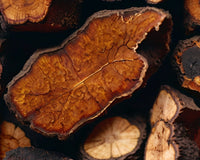Alangium chinense, commonly known as Alangium chinense, is a flowering plant of the Alangium genus in the Dogwood family. Native to East Asia, including China and Japan, the aniseed maple has cultural and medicinal properties. Traditional practitioners have recognized its potential health benefits and utilize various parts of the plant, such as leaves, bark and roots, for its medicinal properties.
Exterior
The characteristic features of the octagonal maple are slender branches, opposite leaves, and small clusters of fragrant white flowers. The flowers have five petals and bloom in spring or early summer. The leaves of the aniseed maple are heart-shaped and appear in a glossy green hue. They are arranged opposite each other on the branches, adding to the beauty of the plant. The fruits of the aniseed maple are small drupes that turn dark purple-black when ripe. Each fruit contains a seed that contributes to the plant's reproductive cycle.
The plant has clusters of small, fragrant flowers that are usually white or yellowish in color. These flowers are composed of multiple petals and emit a pleasant fragrance.
Habitat
This plant typically grows in forests, woodlands, and shrublands. It adapts well to different soil types and can usually grow in sandy or loamy soils. This hardy plant is known for its adaptability and ability to withstand a variety of environmental conditions.
Medicinal uses
This plant is commonly used in Chinese herbalism and is considered one of the 50 essential herbs. The roots and stems have blood-tonifying, carminative and contraceptive properties. They are used to treat rheumatism, numbness, injuries from falls, wounds, and snake bites.
It is said that the soup of leaf buds is a tonic. Apply root paste to the area around the dislocated bones to help them stay in place. The stems, root bark and the whole plant can be used as medicine.
In traditional Chinese medicine, various parts of the maple, including the bark and roots, are used for their medicinal properties. They are thought to have anti-inflammatory, analgesic and antipyretic properties and have been used to treat conditions such as rheumatism, fever and pain. Used as a traditional folk medicine by the people of Southeast Asia to treat rheumatism, skin diseases, and diabetes.
health benefits
- anti-inflammatory properties
- relief the pain
- Antioxidant support
- wound healing
- Gastrointestinal health
- Good for the respiratory system
- immune system support
- skin health
- liver health
- cardiovascular support
- relieve pressure
- antibacterial properties
Compound composition
Anise maple contains the following compounds
- cis-10-eicosenoic acid
- (2S)-5-Hydroxy-7-methoxydihydroflavone
- stigmast-4-en-3,6-dione
- β-Carotesterol
- xanthophyllin
- lacinilene C
- (1S)-1-methoxylacinilene C
- machilin-1
- perseal F
- (−)-Kobusin
- (+)-Fajisin
- tifusin
- 3,3', 4'-Tetra-O-methylellagic acid
- (1R,6S)-6-Aminocyclohex-2-ene-1-carboxylic acid
- Hsinophylline
- (2S)-N-Hydroxybenzylhsinophylline
- 3,3',4,4'-Tetra-O-methylellagic acid
- 3,4'-Di-O-methylellagic acid
- 3,4-Methylenedioxy-3'-O-methyl-4'-O-glucoside ellagic acid
- Araliacerebroside
- uric acid
- Chloropyrazine
- (S)-3,4,5-trihydroxy-1H-pyrrole-2 (5H)-one
- uvacalol k
- salicin
cultural significance
The anise maple has cultural significance in some areas of its native range. It can be grown as an ornamental shrub in the garden or used in landscaping for its attractive flowers and foliage.
conservation status
Although Chinese star anise is not considered globally threatened, habitat loss and overexploitation for medicinal purposes may pose local threats to some populations.





